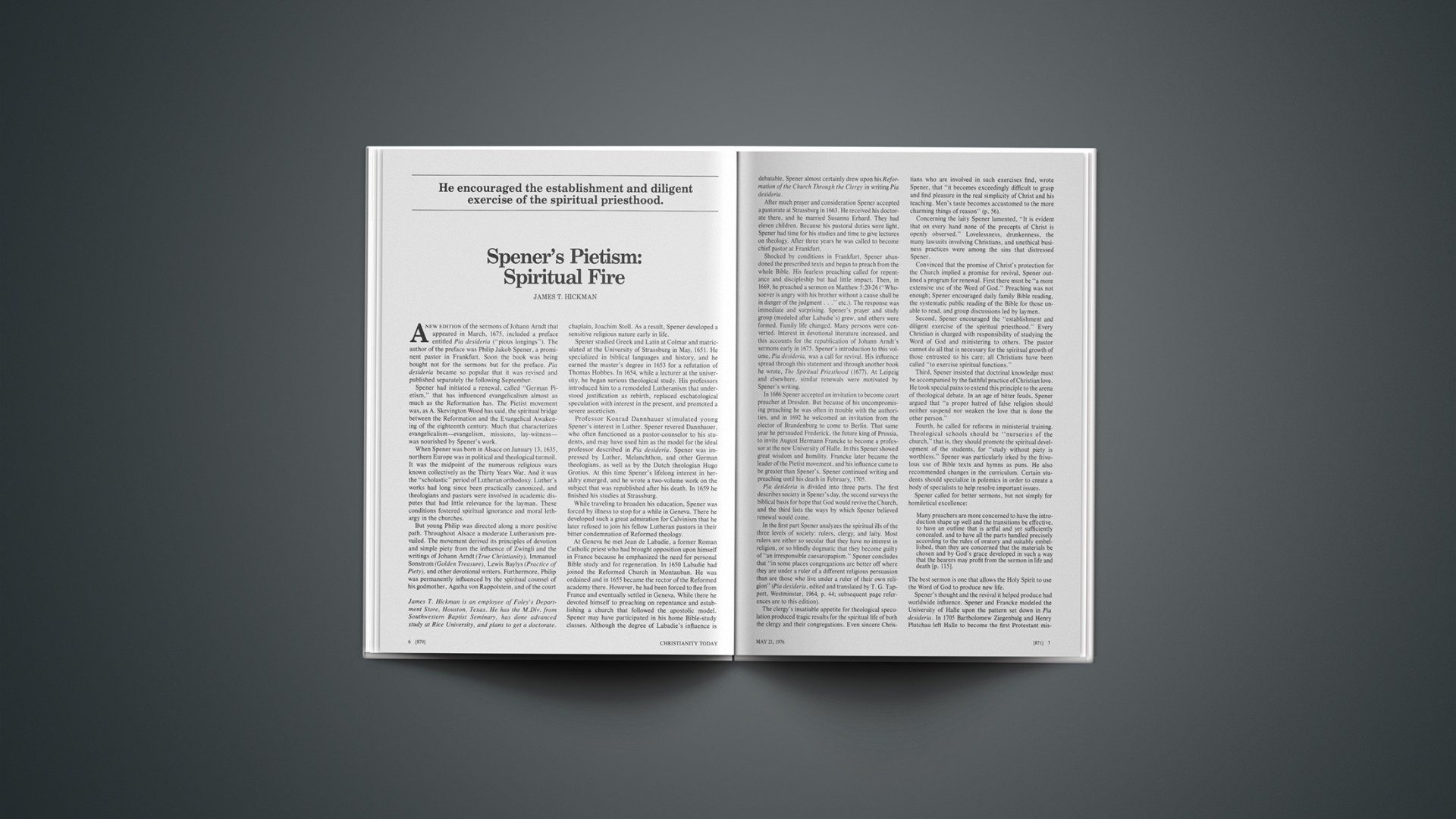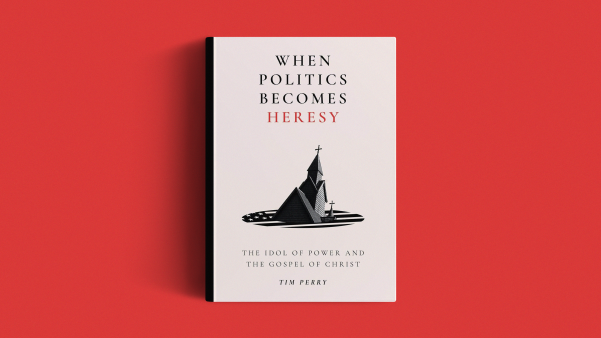A new edition of the sermons of Johann Arndt that appeared in March, 1675, included a preface entitled Pia desideria (“pious longings”). The author of the preface was Philip Jakob Spener, a prominent pastor in Frankfurt. Soon the book was being bought not for the sermons but for the preface. Pia desideria became so popular that it was revised and published separately the following September.
Spener had initiated a renewal, called “German Pietism,” that has influenced evangelicalism almost as much as the Reformation has. The Pietist movement was, as A. Skevington Wood has said, the spiritual bridge between the Reformation and the Evangelical Awakening of the eighteenth century. Much that characterizes evangelicalism—evangelism, missions, lay-witness—was nourished by Spener’s work.
When Spener was born in Alsace on January 13, 1635, northern Europe was in political and theological turmoil. It was the midpoint of the numerous religious wars known collectively as the Thirty Years War. And it was the “scholastic” period of Lutheran orthodoxy. Luther’s works had long since been practically canonized, and theologians and pastors were involved in academic disputes that had little relevance for the layman. These conditions fostered spiritual ignorance and moral lethargy in the churches.
But young Philip was directed along a more positive path. Throughout Alsace a moderate Lutheranism prevailed. The movement derived its principles of devotion and simple piety from the influence of Zwingli and the writings of Johann Arndt (True Christianity), Immanuel Sonstrom (Golden Treasure), Lewis Baylys (Practice of Piety), and other devotional writers. Furthermore, Philip was permanently influenced by the spiritual counsel of his godmother, Agatha von Rappolstein, and of the court chaplain, Joachim Stoll. As a result, Spener developed a sensitive religious nature early in life.
Spener studied Greek and Latin at Colmar and matriculated at the University of Strassburg in May, 1651. He specialized in biblical languages and history, and he earned the master’s degree in 1653 for a refutation of Thomas Hobbes. In 1654, while a lecturer at the university, he began serious theological study. His professors introduced him to a remodeled Lutheranism that understood justification as rebirth, replaced eschatological speculation with interest in the present, and promoted a severe asceticism.
Professor Konrad Dannhauer stimulated young Spener’s interest in Luther. Spener revered Dannhauer, who often functioned as a pastor-counselor to his students, and may have used him as the model for the ideal professor described in Pia desideria. Spener was impressed by Luther, Melanchthon, and other German theologians, as well as by the Dutch theologian Hugo Grotius. At this time Spener’s lifelong interest in heraldry emerged, and he wrote a two-volume work on the subject that was republished after his death. In 1659 he finished his studies at Strassburg.
While traveling to broaden his education, Spener was forced by illness to stop for a while in Geneva. There he developed such a great admiration for Calvinism that he later refused to join his fellow Lutheran pastors in their bitter condemnation of Reformed theology.
At Geneva he met Jean de Labadie, a former Roman Catholic priest who had brought opposition upon himself in France because he emphasized the need for personal Bible study and for regeneration. In 1650 Labadie had joined the Reformed Church in Montauban. He was ordained and in 1655 became the rector of the Reformed academy there. However, he had been forced to flee from France and eventually settled in Geneva. While there he devoted himself to preaching on repentance and establishing a church that followed the apostolic model. Spener may have participated in his home Bible-study classes. Although the degree of Labadie’s influence is debatable, Spener almost certainly drew upon his Reformation of the Church Through the Clergy in writing Pia desideria.
After much prayer and consideration Spener accepted a pastorate at Strassburg in 1663. He received his doctorate there, and he married Susanna Erhard. They had eleven children. Because his pastoral duties were light, Spener had time for his studies and time to give lectures on theology. After three years he was called to become chief pastor at Frankfurt.
Shocked by conditions in Frankfurt, Spener abandoned the prescribed texts and began to preach from the whole Bible. His fearless preaching called for repentance and discipleship but had little impact. Then, in 1669, he preached a sermon on Matthew 5:20–26 (“Whosoever is angry with his brother without a cause shall be in danger of the judgment …” etc.). The response was immediate and surprising. Spener’s prayer and study group (modeled after Labadie’s) grew, and others were formed. Family life changed. Many persons were converted. Interest in devotional literature increased, and this accounts for the republication of Johann Arndt’s sermons early in 1675. Spener’s introduction to this volume, Pia desideria, was a call for revival. His influence spread through this statement and through another book he wrote, The Spiritual Priesthood (1677). At Leipzig and elsewhere, similar renewals were motivated by Spener’s writing.
In 1686 Spener accepted an invitation to become court preacher at Dresden. But because of his uncompromising preaching he was often in trouble with the authorities, and in 1692 he welcomed an invitation from the elector of Brandenburg to come to Berlin. That same year he persuaded Frederick, the future king of Prussia, to invite August Hermann Francke to become a professor at the new University of Halle. In this Spener showed great wisdom and humility. Francke later became the leader of the Pietist movement, and his influence came to be greater than Spener’s. Spener continued writing and preaching until his death in February, 1705.
Pia desideria is divided into three parts. The first describes society in Spener’s day, the second surveys the biblical basis for hope that God would revive the Church, and the third lists the ways by which Spener believed renewal would come.
In the first part Spener analyzes the spiritual ills of the three levels of society: rulers, clergy, and laity. Most rulers are either so secular that they have no interest in religion, or so blindly dogmatic that they become guilty of “an irresponsible caesaropapism.” Spener concludes that “in some places congregations are better off where they are under a ruler of a different religious persuasion than are those who live under a ruler of their own religion” (Pia desideria, edited and translated by T. G. Tappert, Westminster, 1964, p. 44; subsequent page references are to this edition).
The clergy’s insatiable appetite for theological speculation produced tragic results for the spiritual life of both the clergy and their congregations. Even sincere Christians who are involved in such exercises find, wrote Spener, that “it becomes exceedingly difficult to grasp and find pleasure in the real simplicity of Christ and his teaching. Men’s taste becomes accustomed to the more charming things of reason” (p. 56).
Concerning the laity Spener lamented, “It is evident that on every hand none of the precepts of Christ is openly observed.” Lovelessness, drunkenness, the many lawsuits involving Christians, and unethical business practices were among the sins that distressed Spener.
Convinced that the promise of Christ’s protection for the Church implied a promise for revival, Spener outlined a program for renewal. First there must be “a more extensive use of the Word of God.” Preaching was not enough; Spener encouraged daily family Bible reading, the systematic public reading of the Bible for those unable to read, and group discussions led by laymen.
Second, Spener encouraged the “establishment and diligent exercise of the spiritual priesthood.” Every Christian is charged with responsibility of studying the Word of God and ministering to others. The pastor cannot do all that is necessary for the spiritual growth of those entrusted to his care; all Christians have been called “to exercise spiritual functions.”
Third, Spener insisted that doctrinal knowledge must be accompanied by the faithful practice of Christian love. He took special pains to extend this principle to the arena of theological debate. In an age of bitter feuds, Spener argued that “a proper hatred of false religion should neither suspend nor weaken the love that is done the other person.”
Fourth, he called for reforms in ministerial training. Theological schools should be “nurseries of the church,” that is, they should promote the spiritual development of the students, for “study without piety is worthless.” Spener was particularly irked by the frivolous use of Bible texts and hymns as puns. He also recommended changes in the curriculum. Certain students should specialize in polemics in order to create a body of specialists to help resolve important issues.
Spener called for better sermons, but not simply for homiletical excellence:
Many preachers are more concerned to have the introduction shape up well and the transitions be effective, to have an outline that is artful and yet sufficiently concealed, and to have all the parts handled precisely according to the rules of oratory and suitably embellished, than they are concerned that the materials be chosen and by God’s grace developed in such a way that the hearers may profit from the sermon in life and death [p. 115].
The best sermon is one that allows the Holy Spirit to use the Word of God to produce new life.
Spener’s thought and the revival it helped produce had worldwide influence. Spener and Francke modeled the University of Halle upon the pattern set down in Pia desideria. In 1705 Bartholomew Ziegenbalg and Henry Plutchau left Halle to become the first Protestant missionaries in India, where they sought to develop an indigenous church. Count von Zinzendorf, another graduate of Halle, became the leader of the Moravians, whose influence on the Evangelical Awakening is suggested in the classic statement of William Warburton about that revival: “William Law was its father, and Count Zinzendorf rocked the cradle.” In the American colonies Theodore Frelinghuysen, a young German Pietist, preached against the shallowness of his Dutch Reformed parishes in New Jersey’s Raritan Valley; from his preaching the middle colonies experienced the first wave of the Great Awakening.
Later doctrinal aberrations, such as the Moravian fascination with the wounds of Christ, and a sentimentalistic tendency to eschew theological precision demanded the counterbalance of a strong orthodoxy, but the spirit of Pietism lives on. Spener’s influence continues in the evangelical tradition of devotion, missions, and evangelism, though his name is often forgotten and the Pietist movement is often ridiculed.










